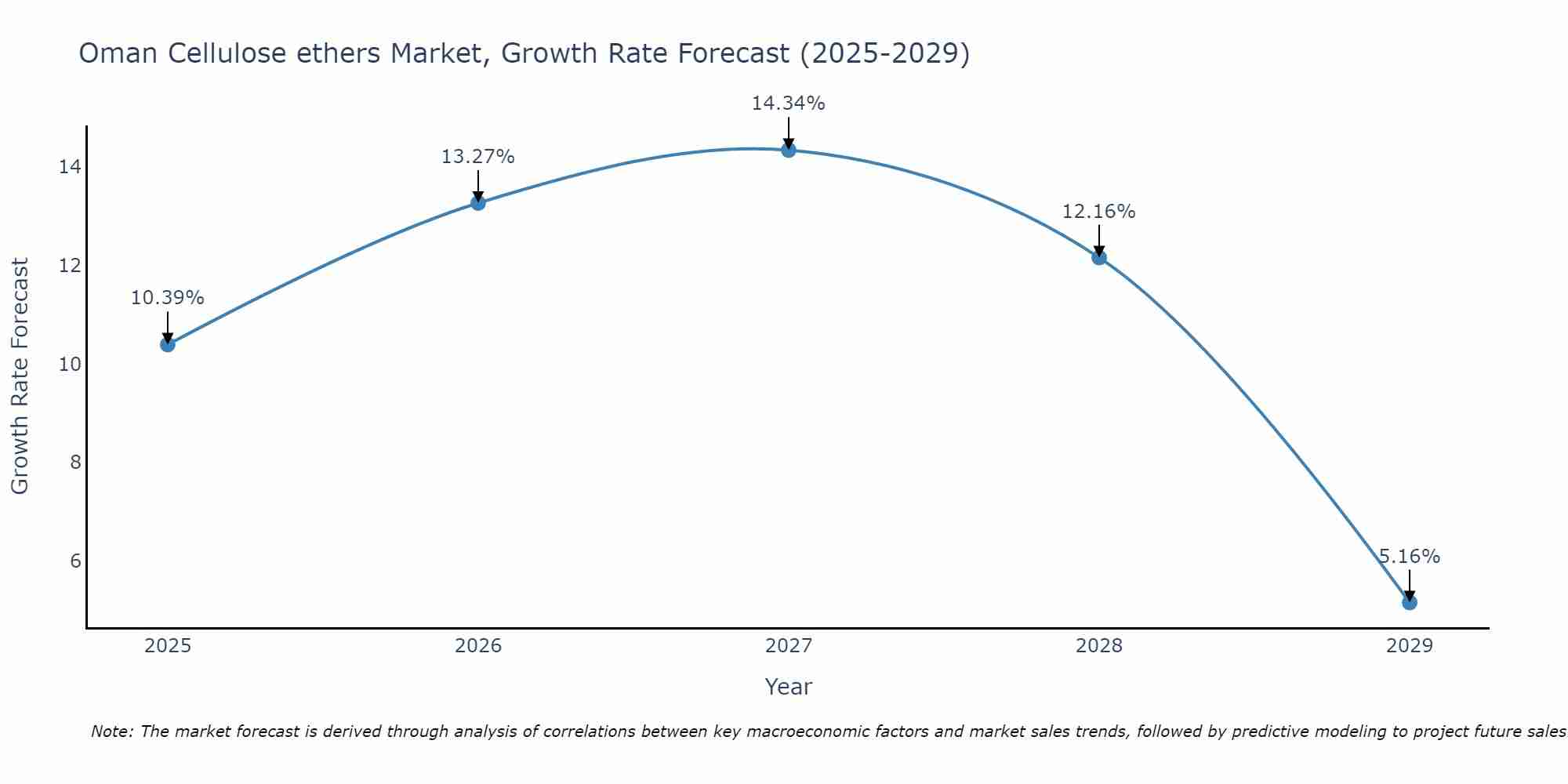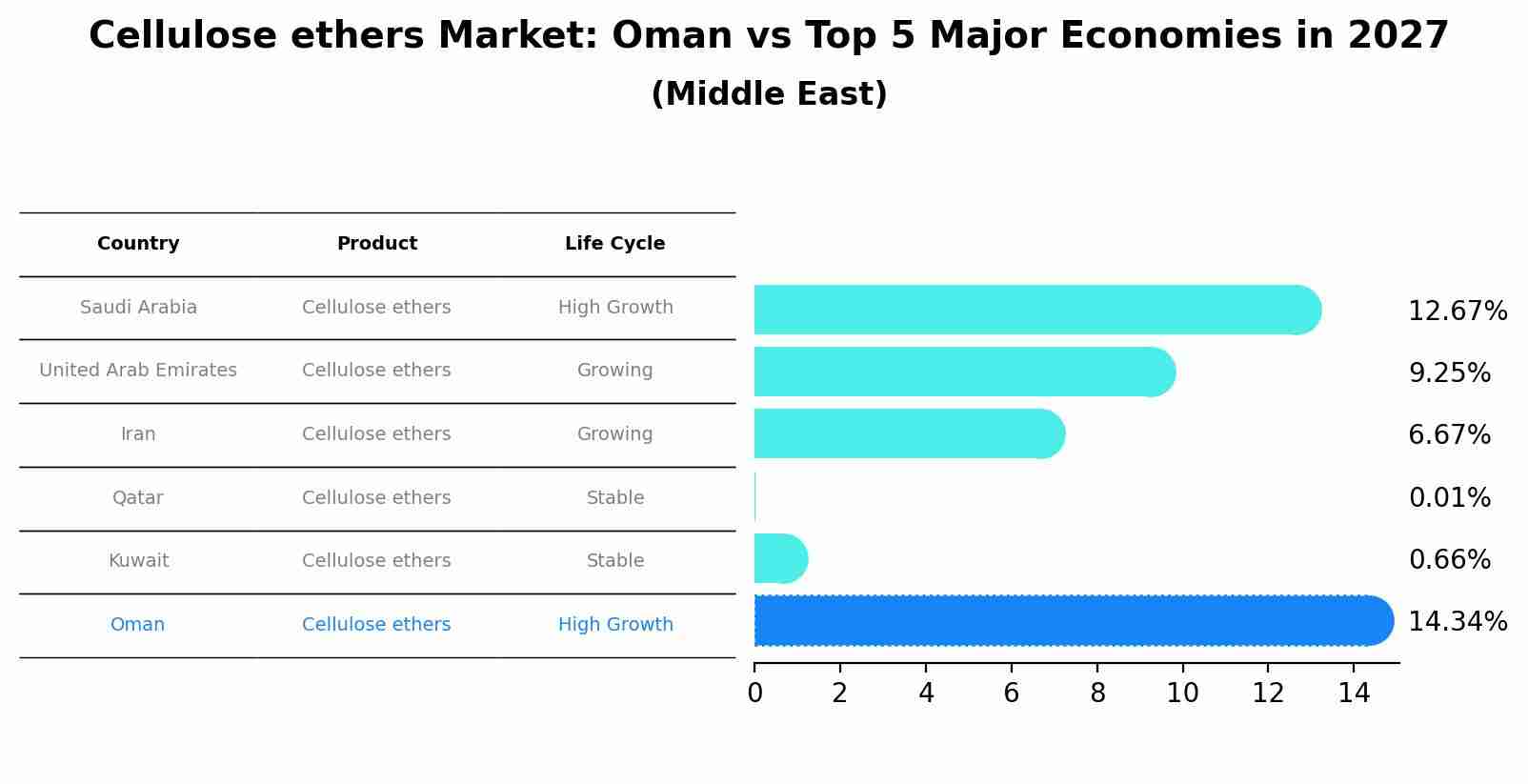Oman Cellulose ethers Market Outlook | Revenue, Companies, Growth, Share, Analysis, Size, Trends, Forecast, COVID-19 IMPACT, Industry & Value
| Product Code: ETC093062 | Publication Date: Jun 2021 | Updated Date: Apr 2025 | Product Type: Report | |
| Publisher: 6Wresearch | Author: Ravi Bhandari | No. of Pages: 70 | No. of Figures: 35 | No. of Tables: 5 |
Oman Cellulose ethers Market Size Growth Rate
The Oman Cellulose ethers Market is projected to witness mixed growth rate patterns during 2025 to 2029. The growth rate begins at 10.39% in 2025, climbs to a high of 14.34% in 2027, and moderates to 5.16% by 2029.

Cellulose ethers Market: Oman vs Top 5 Major Economies in 2027 (Middle East)
In the Middle East region, the Cellulose ethers market in Oman is projected to expand at a high growth rate of 14.34% by 2027. The largest economy is Saudi Arabia, followed by United Arab Emirates, Iran, Qatar and Kuwait.

Oman Cellulose ethers Market Overview
The cellulose ethers market in Oman is witnessing growth propelled by the increasing demand for water-soluble polymers in industries such as construction, pharmaceuticals, and personal care. Cellulose ethers, known for their thickening, binding, and film-forming properties, find applications in adhesives, pharmaceutical formulations, and food products. Manufacturers are focusing on developing innovative cellulose ether derivatives with enhanced performance characteristics to meet the evolving needs of end-users in Oman.
Drivers of the market
The growth of the construction industry, particularly in the residential and commercial sectors, is a key driver for the cellulose ethers market in Oman. Cellulose ethers are extensively used in various construction materials such as mortars, plasters, and grouts, which are in high demand due to ongoing infrastructure development projects.
Challenges of the market
The cellulose ethers market in Oman faces challenges related to the availability and cost of raw materials, particularly cellulose derivatives such as methyl cellulose and hydroxyethyl cellulose. Fluctuations in cellulose prices and supply chain disruptions can impact the profitability of manufacturers and affect pricing strategies. Moreover, addressing concerns related to product performance, consistency, and compatibility with various applications poses challenges for ensuring customer satisfaction and market competitiveness.
Government Policy of the market
The government of Oman may implement regulations and standards to ensure the safety, quality, and environmental sustainability of cellulose ethers used in industries such as construction, food, and pharmaceuticals. Policies may include oversight of manufacturing processes to minimize environmental impact and ensure compliance with safety standards, as well as regulations governing product labeling and packaging. Additionally, government support for industries that rely on cellulose ethers, such as infrastructure development and healthcare, may indirectly influence market demand through economic development initiatives.
Key Highlights of the Report:
- Oman Cellulose ethers Market Outlook
- Market Size of Oman Cellulose ethers Market, 2024
- Forecast of Oman Cellulose ethers Market, 2031
- Historical Data and Forecast of Oman Cellulose ethers Revenues & Volume for the Period 2018 - 2031
- Oman Cellulose ethers Market Trend Evolution
- Oman Cellulose ethers Market Drivers and Challenges
- Oman Cellulose ethers Price Trends
- Oman Cellulose ethers Porter's Five Forces
- Oman Cellulose ethers Industry Life Cycle
- Historical Data and Forecast of Oman Cellulose ethers Market Revenues & Volume By Product Type for the Period 2018 - 2031
- Historical Data and Forecast of Oman Cellulose ethers Market Revenues & Volume By Carboxymethyl Cellulose for the Period 2018 - 2031
- Historical Data and Forecast of Oman Cellulose ethers Market Revenues & Volume By Methyl Cellulose & Derivatives for the Period 2018 - 2031
- Historical Data and Forecast of Oman Cellulose ethers Market Revenues & Volume By Hydroxyethyl Cellulose for the Period 2018 - 2031
- Historical Data and Forecast of Oman Cellulose ethers Market Revenues & Volume By Others for the Period 2018 - 2031
- Historical Data and Forecast of Oman Cellulose ethers Market Revenues & Volume By Application for the Period 2018 - 2031
- Historical Data and Forecast of Oman Cellulose ethers Market Revenues & Volume By Food and Beverage for the Period 2018 - 2031
- Historical Data and Forecast of Oman Cellulose ethers Market Revenues & Volume By Pharmaceuticals and Healthcare for the Period 2018 - 2031
- Historical Data and Forecast of Oman Cellulose ethers Market Revenues & Volume By Construction for the Period 2018 - 2031
- Historical Data and Forecast of Oman Cellulose ethers Market Revenues & Volume By Cosmetics for the Period 2018 - 2031
- Historical Data and Forecast of Oman Cellulose ethers Market Revenues & Volume By Personal Care for the Period 2018 - 2031
- Historical Data and Forecast of Oman Cellulose ethers Market Revenues & Volume By Others for the Period 2018 - 2031
- Oman Cellulose ethers Import Export Trade Statistics
- Market Opportunity Assessment By Product Type
- Market Opportunity Assessment By Application
- Oman Cellulose ethers Top Companies Market Share
- Oman Cellulose ethers Competitive Benchmarking By Technical and Operational Parameters
- Oman Cellulose ethers Company Profiles
- Oman Cellulose ethers Key Strategic Recommendations
Frequently Asked Questions About the Market Study (FAQs):
1 Executive Summary |
2 Introduction |
2.1 Key Highlights of the Report |
2.2 Report Description |
2.3 Market Scope & Segmentation |
2.4 Research Methodology |
2.5 Assumptions |
3 Oman Cellulose ethers Market Overview |
3.1 Oman Country Macro Economic Indicators |
3.2 Oman Cellulose ethers Market Revenues & Volume, 2021 & 2031F |
3.3 Oman Cellulose ethers Market - Industry Life Cycle |
3.4 Oman Cellulose ethers Market - Porter's Five Forces |
3.5 Oman Cellulose ethers Market Revenues & Volume Share, By Product Type, 2021 & 2031F |
3.6 Oman Cellulose ethers Market Revenues & Volume Share, By Application, 2021 & 2031F |
4 Oman Cellulose ethers Market Dynamics |
4.1 Impact Analysis |
4.2 Market Drivers |
4.3 Market Restraints |
5 Oman Cellulose ethers Market Trends |
6 Oman Cellulose ethers Market, By Types |
6.1 Oman Cellulose ethers Market, By Product Type |
6.1.1 Overview and Analysis |
6.1.2 Oman Cellulose ethers Market Revenues & Volume, By Product Type, 2021-2031F |
6.1.3 Oman Cellulose ethers Market Revenues & Volume, By Carboxymethyl Cellulose, 2021-2031F |
6.1.4 Oman Cellulose ethers Market Revenues & Volume, By Methyl Cellulose & Derivatives, 2021-2031F |
6.1.5 Oman Cellulose ethers Market Revenues & Volume, By Hydroxyethyl Cellulose, 2021-2031F |
6.1.6 Oman Cellulose ethers Market Revenues & Volume, By Others, 2021-2031F |
6.2 Oman Cellulose ethers Market, By Application |
6.2.1 Overview and Analysis |
6.2.2 Oman Cellulose ethers Market Revenues & Volume, By Food and Beverage, 2021-2031F |
6.2.3 Oman Cellulose ethers Market Revenues & Volume, By Pharmaceuticals and Healthcare, 2021-2031F |
6.2.4 Oman Cellulose ethers Market Revenues & Volume, By Construction, 2021-2031F |
6.2.5 Oman Cellulose ethers Market Revenues & Volume, By Cosmetics, 2021-2031F |
6.2.6 Oman Cellulose ethers Market Revenues & Volume, By Personal Care, 2021-2031F |
6.2.7 Oman Cellulose ethers Market Revenues & Volume, By Others, 2021-2031F |
7 Oman Cellulose ethers Market Import-Export Trade Statistics |
7.1 Oman Cellulose ethers Market Export to Major Countries |
7.2 Oman Cellulose ethers Market Imports from Major Countries |
8 Oman Cellulose ethers Market Key Performance Indicators |
9 Oman Cellulose ethers Market - Opportunity Assessment |
9.1 Oman Cellulose ethers Market Opportunity Assessment, By Product Type, 2021 & 2031F |
9.2 Oman Cellulose ethers Market Opportunity Assessment, By Application, 2021 & 2031F |
10 Oman Cellulose ethers Market - Competitive Landscape |
10.1 Oman Cellulose ethers Market Revenue Share, By Companies, 2024 |
10.2 Oman Cellulose ethers Market Competitive Benchmarking, By Operating and Technical Parameters |
11 Company Profiles |
12 Recommendations |
13 Disclaimer |
- Single User License$ 1,995
- Department License$ 2,400
- Site License$ 3,120
- Global License$ 3,795
Search
Related Reports
- ASEAN Bearings Market (2025-2031) | Strategy, Consumer Insights, Analysis, Investment Trends, Opportunities, Growth, Size, Share, Industry, Revenue, Segments, Value, Segmentation, Supply, Forecast, Restraints, Outlook, Competition, Drivers, Trends, Demand, Pricing Analysis, Competitive, Strategic Insights, Companies, Challenges
- Europe Flooring Market (2025-2031) | Outlook, Share, Industry, Trends, Forecast, Companies, Revenue, Size, Analysis, Growth & Value
- Saudi Arabia Manlift Market (2025-2031) | Outlook, Size, Growth, Trends, Companies, Industry, Revenue, Value, Share, Forecast & Analysis
- Uganda Excavator, Crane, and Wheel Loaders Market (2025-2031) | Strategy, Consumer Insights, Analysis, Investment Trends, Opportunities, Growth, Size, Share, Industry, Revenue, Segments, Value, Segmentation, Supply, Forecast, Restraints, Outlook, Competition, Drivers, Trends, Demand, Pricing Analysis, Competitive, Strategic Insights, Companies, Challenges
- Rwanda Excavator, Crane, and Wheel Loaders Market (2025-2031) | Strategy, Consumer Insights, Analysis, Investment Trends, Opportunities, Growth, Size, Share, Industry, Revenue, Segments, Value, Segmentation, Supply, Forecast, Restraints, Outlook, Competition, Drivers, Trends, Demand, Pricing Analysis, Competitive, Strategic Insights, Companies, Challenges
- Kenya Excavator, Crane, and Wheel Loaders Market (2025-2031) | Strategy, Consumer Insights, Analysis, Investment Trends, Opportunities, Growth, Size, Share, Industry, Revenue, Segments, Value, Segmentation, Supply, Forecast, Restraints, Outlook, Competition, Drivers, Trends, Demand, Pricing Analysis, Competitive, Strategic Insights, Companies, Challenges
- Angola Excavator, Crane, and Wheel Loaders Market (2025-2031) | Strategy, Consumer Insights, Analysis, Investment Trends, Opportunities, Growth, Size, Share, Industry, Revenue, Segments, Value, Segmentation, Supply, Forecast, Restraints, Outlook, Competition, Drivers, Trends, Demand, Pricing Analysis, Competitive, Strategic Insights, Companies, Challenges
- Israel Intelligent Transport System Market (2025-2031) | Strategy, Consumer Insights, Analysis, Investment Trends, Opportunities, Growth, Size, Share, Industry, Revenue, Segments, Value, Segmentation, Supply, Forecast, Restraints, Outlook, Competition, Drivers, Trends, Demand, Pricing Analysis, Competitive, Strategic Insights, Companies, Challenges
- Uganda Precast and Aggregate Market (2025-2031) | Strategy, Consumer Insights, Analysis, Investment Trends, Opportunities, Growth, Size, Share, Industry, Revenue, Segments, Value, Segmentation, Supply, Forecast, Restraints, Outlook, Competition, Drivers, Trends, Demand, Pricing Analysis, Competitive, Strategic Insights, Companies, Challenges
- Australia IT Asset Disposal Market (2025-2031) | Strategy, Consumer Insights, Analysis, Investment Trends, Opportunities, Growth, Size, Share, Industry, Revenue, Segments, Value, Segmentation, Supply, Forecast, Restraints, Outlook, Competition, Drivers, Trends, Demand, Pricing Analysis, Competitive, Strategic Insights, Companies, Challenges
Industry Events and Analyst Meet
Our Clients
Whitepaper
- Middle East & Africa Commercial Security Market Click here to view more.
- Middle East & Africa Fire Safety Systems & Equipment Market Click here to view more.
- GCC Drone Market Click here to view more.
- Middle East Lighting Fixture Market Click here to view more.
- GCC Physical & Perimeter Security Market Click here to view more.
6WResearch In News
- Doha a strategic location for EV manufacturing hub: IPA Qatar
- Demand for luxury TVs surging in the GCC, says Samsung
- Empowering Growth: The Thriving Journey of Bangladesh’s Cable Industry
- Demand for luxury TVs surging in the GCC, says Samsung
- Video call with a traditional healer? Once unthinkable, it’s now common in South Africa
- Intelligent Buildings To Smooth GCC’s Path To Net Zero













